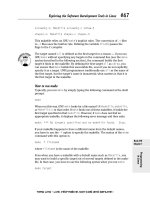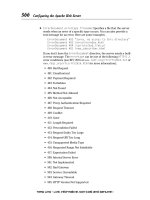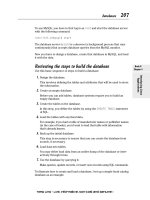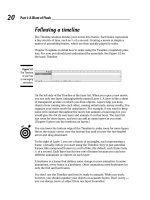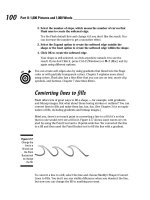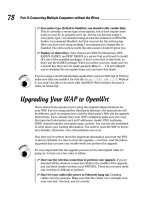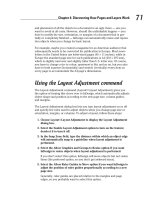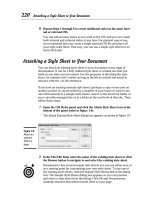Hacking FOR DUMmIES phần 4 ppsx
Bạn đang xem bản rút gọn của tài liệu. Xem và tải ngay bản đầy đủ của tài liệu tại đây (1.04 MB, 38 trang )
ߜ Demonstrate how to create secure passwords. You may want to refer to
them as pass codes or pass phrases, because people tend to take the
word passwords literally and use only words, which can be less secure.
ߜ Show what can happen when weak passwords are used or passwords
are shared.
ߜ Diligently build user awareness of social-engineering attacks.
Enforce (or encourage the use of) a strong password-creation policy that
includes the following criteria:
ߜ Use upper- and lowercase letters, special characters, and numbers.
(Never use only numbers. These passwords can be cracked quickly.)
ߜ Misspell words or create acronyms from a quote or a sentence. (An
acronym is a word created from the initials of a phrase. For example,
ASCII is an acronym for American Standard Code for Information
Interchange.)
ߜ Use punctuation characters to separate words or acronyms.
ߜ Change passwords every 6 to 12 months.
ߜ Use different passwords for each system. This is especially important
for network-infrastructure hosts, such as servers, firewalls, and routers.
ߜ Use variable-length passwords. This can throw off the hackers, because
they won’t know the required minimum or maximum length of passwords
and must try all password length combinations.
ߜ Don’t use common slang words or words that are in a dictionary.
ߜ Don’t use similar-looking characters, such as 3 instead of E, 5 instead
of S, or ! instead of 1. Password-cracking programs can check for this.
ߜ Don’t reuse the same password within 12 months.
ߜ Use password-protected screen savers.
ߜ Don’t share passwords.
ߜ Avoid storing user passwords in a central place, such as an unsecured
spreadsheet on a hard drive. This is an invitation for disaster. Use PGP,
Password Safe, or a similar program to store user passwords.
Other considerations
Here are some other password-hacking countermeasures that I recommend:
ߜ Enable security auditing to help monitor and track password attacks.
ߜ Test your applications to make sure they aren’t storing passwords in
memory or writing them to disk.
93
Chapter 7: Passwords
11 55784x Ch07.qxd 3/29/04 4:15 PM Page 93
Some password-cracking Trojan-horse applications are transmitted
through worms or simple e-mail attachments, such as
VBS.Network.B and
PWSteal.SoapSpy. These applications can be lethal to your password-
protection mechanisms if they’re installed on your systems. The best
defense is malware protection software, such as antivirus protection
(from a vendor like Norton or McAfee), spyware protection (such as
PestPatrol or Spybot), or malicious-code behavioral protection (such
as Finjan’s offerings).
ߜ Keep your systems patched. Passwords are reset or compromised
during buffer overflows or other DoS conditions.
ߜ Know your user IDs. If an account has never been used, delete or
disable the account until it’s needed. You can determine unused
accounts by manual inspection or by using a tool such as DumpSec
(
www.somarsoft.com), which can enumerate the Windows operating
system and gather user ID and other information.
As the security administrator in your organization, you can enable account
lockout to prevent password-cracking attempts. Most operating systems and
some applications have this capability. Don’t set it too low (less than five failed
logins), and don’t set it too high to give a malicious user a greater chance of
breaking in. Somewhere between 5 and 50 may work for you. I usually recom-
mend a setting of around 10 or 15.
ߜ To use account lockout and prevent any possibilities of a user DoS con-
dition, require two different passwords, and don’t set a lockout time for
the first one.
ߜ If you permit auto reset of the account after a certain time period —
often referred to as intruder lockout — don’t set a short time period.
Thirty minutes often works well.
A failed login counter can increase password security and minimize the over-
all effects if the account is being compromised by an automated attack. It can
force a password change after a number of failed attempts. If the number of
failed login attempts is high, and they all occurred in a short period of time,
the account has likely experienced an automated password attack.
Some more password-protection countermeasures include the following:
ߜ Use stronger authentication methods, such as challenge/response, smart
cards, tokes, biometrics, or digital certificates.
ߜ Automate password reset. This functionality lets users to manage most
of their password problems without getting others involved. Otherwise,
this support issue becomes expensive, especially for larger organizations.
ߜ Password-protect the system BIOS (basic input/output system). This is
especially important on servers and laptops that are susceptible to
physical-security threats and vulnerabilities.
94
Part II: Putting Ethical Hacking in Motion
11 55784x Ch07.qxd 3/29/04 4:15 PM Page 94
Password-protected files
Do you wonder how vulnerable word-processing, spreadsheet, and zip files
are as users send them into the wild blue yonder? Wonder no more. Some
great utilities can show how easily passwords are cracked.
Cracking files
Most password-protected files can be cracked in seconds or minutes. You can
demonstrate this “wow-factor” security vulnerability to users and manage-
ment. Here’s a real-world scenario:
ߜ Your CFO wants to send some confidential financial information in an
Excel spreadsheet to the company’s outside financial advisor.
ߜ She protects the spreadsheet by assigning a password to it during the
file-save process in Excel 2002.
ߜ For good measure, she uses WinZip to compress the file, and adds
another password to make it really secure.
ߜ The CFO sends the spreadsheet as an e-mail attachment, assuming that
it will reach its destination securely.
The financial advisor’s network has content filtering, which monitors
incoming e-mails for keywords and file attachments. Unfortunately, the
financial advisory firm’s network administrator is looking in the content-
filtering system to see what’s coming in.
ߜ This rogue network administrator finds the e-mail with the con-
fidential attachment, saves the attachment, and realizes that it’s
password-protected.
ߜ The network administrator remembers some great password-cracking
utilities from ElcomSoft (
www.elcomsoft.com) that can help him out. He
may see something like Figures 7-5 and 7-6.
Cracking password-protected files is as simple as that! Now all that the rogue
network administrator must do is forward the confidential spreadsheet to his
buddies or the company’s competitors.
If you carefully select the right options in Advanced ZIP Password Recovery
and Office XP Password Recovery, you can drastically shorten your testing
time. For example, if you know that a password is not over 5 characters or is
lowercase letters only, you can cut the cracking time in half.
I recommend performing these file password-cracking tests on files that you
capture with a content-filtering or network-analysis tool.
95
Chapter 7: Passwords
11 55784x Ch07.qxd 3/29/04 4:15 PM Page 95
Countermeasures
The best defense against weak file password protection is to require your
users to use a stronger form of file protection, such as PGP, when necessary.
Ideally, you don’t want to rely on users to make decisions about what they
should use this method to secure, but it’s better than nothing. Stress that a
file-encryption mechanism such as PGP is secure only if users keep their
passwords confidential and never transmit or store them in clear text.
Figure 7-6:
ElcomSoft’s
Advanced
Office XP
Password
Recovery
cracking
a spread-
sheet.
Figure 7-5:
ElcomSoft’s
Advanced
ZIP
Password
Recovery
cracking a
zip file.
96
Part II: Putting Ethical Hacking in Motion
11 55784x Ch07.qxd 3/29/04 4:15 PM Page 96
If you’re concerned about nonsecure transmissions through e-mail, consider
one of these options:
ߜ Block all outbound e-mail attachments that aren’t protected on your
e-mail server.
ߜ Use an encryption program, such as PGP, to create self-extracting
encrypted files.
ߜ Use content-filtering applications.
Other ways to crack passwords
Over the years, I’ve found other ways to crack passwords, both technically
and through social engineering.
Keystroke logging
One of the best techniques for cracking passwords is remote keystroke
logging — the use of software or hardware to record keystrokes as they’re
being typed into the computer.
Be careful with keystroke logging. Even with good intentions, monitoring
employees can raise some legal issues. Discuss what you’ll be doing with
your legal counsel, and get approval from upper management.
Logging tools
With keystroke-logging tools, you can later assess the log files of your appli-
cation to see what passwords people are using:
ߜ Keystroke-logging applications can be installed on the monitored com-
puter. I recommend that you check out eBlaster and Spector Pro by
SpectorSoft (
www.spectorsoft.com). Another popular tool that you
can use is Invisible KeyLogger Stealth, at
www.amecisco.com/iks.htm,
as well as the hardware-based KeyGhost (
www.keyghost.com). Dozens
of other such tools are available on the Internet.
ߜ Hardware-based tools fit between the keyboard and the computer or
replace the keyboard altogether.
A shared computer can capture the passwords of every user who logs in.
Countermeasures
The best defense against the installation of keystroke-logging software on
your systems is a spyware-detection program or popular antivirus products.
97
Chapter 7: Passwords
11 55784x Ch07.qxd 3/29/04 4:15 PM Page 97
The potential for hackers to install keystroke-logging software is another
reason to ensure that your users aren’t downloading and installing random
shareware or opening attachments in unsolicited e-mails. Consider locking
down your desktops by setting the appropriate user rights through local or
group security policy in Windows. Alternatively, you could use a commercial
lock-down program, such as Fortres 101 (
www.fortres.com) for Windows or
Deep Freeze (
www.deepfreezeusa.com) for Windows and Mac OS X.
Weak password storage
Many legacy and stand-alone applications such as e-mail, dial-up network
connections, and accounting software store passwords locally, making them
vulnerable to password hacking. By performing a basic text search, I’ve found
passwords stored in clear text on the local hard drives of machines.
Searching
You can try using your favorite text-searching utility — such as the Windows
search function,
findstr, or grep — to search for password or passwd on your
drives. You may be shocked to find what’s on your systems. Some programs
even write passwords to disk or leave them stored in memory.
This is a hacker’s dream. Head it off if you can.
Countermeasures
The only reliable way to eliminate weak password storage is to use only appli-
cations that store passwords securely. This may not be practical, but it’s your
only guarantee that your passwords are secure.
Before upgrading applications, contact your software vendor or search for a
third-party solution.
Network analyzer
A network analyzer sniffs the packets traversing the network. This is what the
bad guys do if they can gain control over a computer or gain physical network
access to set up their network analyzer. If they gain physical access, they can
look for a network jack on the wall and plug right in!
Testing
Figure 7-7 shows how crystal-clear passwords can be through the eyes of a
network analyzer. This figure shows the password packet from an EtherPeek
capture of a POP3 session using Microsoft Outlook to download messages
from an e-mail server. Look in the POP — Post Office Protocol section for the
password of “MyPassword”. These same clear-text password vulnerabilities
can apply to instant messaging, Web-site logins, telnet sessions, and more.
Basically, if traffic is not being tunneled through a VPN, SSH, SSL, or some
other form of encrypted link, it’s vulnerable to attack.
98
Part II: Putting Ethical Hacking in Motion
11 55784x Ch07.qxd 3/29/04 4:15 PM Page 98
Although you can benefit from using a commercial network analyzer such as
EtherPeek, you don’t need to buy one for your testing. An open-source pro-
gram, Ethereal, runs on Windows and UNIX platforms. You can search for
password traffic on the network a million ways. For example, to capture POP3
password traffic, set up a trigger to search for the PASS command. When the
network analyzer sees the PASS command in the packet, it starts capturing
data until your specified time or number of packets.
Capture this data on a hub segment of your network, or plug your network-
analyzer system into a monitor port on a switch. Otherwise, you can’t see
anyone else’s data traversing the network — just yours. Check your switch’s
user’s guide for whether it has a monitor or mirror port and instructions on
how to configure it. You can connect your network analyzer to a hub on the
public side of your firewall. You’ll capture only those packets that are enter-
ing or leaving your network — not internal traffic.
Countermeasures
Here are some good defenses against network-analyzer attacks:
ߜ Use switches on your network, not hubs.
If you must use hubs on network segments, a program such as sniffdet,
cpm, and sentinel can detect network cards in promiscuous mode
(accepting all packets, whether destined for it or not). Network cards in
this mode are signs of a network analyzer running on the network.
ߜ Don’t let a hacker gain physical access to your switches or the network
connection on the public side of your firewall. With physical access, a
hacker can connect to a switch monitor port, or tap into the unswitched
network segment outside the firewall and capture packets.
Switches do not provide complete security because they are vulnerable to
ARP poisoning attacks, which I cover in Chapter 9.
Most computer BIOSs allow power-on passwords and/or setup passwords to
protect the computer’s hardware settings that are stored in the CMOS chip.
Here are some ways around these passwords:
Figure 7-7:
An
EtherPeek
capture
of a POP3
password
packet.
99
Chapter 7: Passwords
11 55784x Ch07.qxd 3/29/04 4:15 PM Page 99
ߜ You can usually reset these passwords by either unplugging the CMOS
battery or changing a jumper on the motherboard.
ߜ Password-cracking utilities for BIOS passwords are available.
Some systems (especially laptops) can’t be reset easily. You can lose all the
hardware settings and lock yourself out of your own computer. If you plan to
hack your own BIOS passwords, check for information in your user manual or
on
labmice.techtarget.com/articles/BIOS_hack.htm on doing this
safely.
Weak passwords in limbo
Bad guys often exploit user accounts that have just been reset by a network
administrator or help desk. Accounts may need to be reset if users forget their
passwords, or if the accounts have been locked out because of failed attempts.
Weaknesses
Here are some reasons why user accounts can be vulnerable:
ߜ When user accounts are reset, they often are assigned an easily cracked
password (such as the user’s name or the word password). The time
between resetting the user account and changing the password is a
prime opportunity for a break-in.
ߜ Many systems have either default accounts or unused accounts with
weak passwords or no passwords at all. These are prime targets.
Countermeasures
The best defenses against attacks on passwords in limbo are solid help-desk
policies and procedures that prevent weak passwords from being available at
any given time during the password-reset process. Perhaps the best ways to
overcome this vulnerability are as follows:
ߜ Require users to be on the phone with the help desk, or have a help-
desk member perform the reset at the user’s desk.
ߜ Require that the user immediately log in and change his password.
ߜ If you need the ultimate in security, implement stronger authentication
methods, such as challenge/response, smart cards, or digital certificates.
ߜ Automate password-reset functionality on your network so users can
manage most of their password problems without help from others.
For a good list of default system passwords for vendor equipment, check
www.cirt.net/cgi-bin/passwd.pl.
Password-reset programs
Network administrators occasionally use administrator password-resetting
programs, which can be used against a network.
100
Part II: Putting Ethical Hacking in Motion
11 55784x Ch07.qxd 3/29/04 4:15 PM Page 100
Tools
One of my favorites for Windows is NTAccess (www.mirider.com/ntaccess.
html)
. This program isn’t fancy, but it does the job.
Countermeasures
The best safeguard against a hacker using a password-reset program against
your systems is to ensure the hacker can’t gain physical access. When a
hacker has physical access, all bets are off.
Securing Operating Systems
You can implement various operating-system security measures to ensure
that passwords are protected.
Regularly perform these low-tech and high-tech password-cracking tests to
make sure that your systems are as secure as possible — perhaps as part of a
monthly, quarterly, or biannual audit.
Windows
The following countermeasures can help prevent password hacks on
Windows systems:
ߜ Some Windows passwords can be gleaned by simply reading the clear
text or crackable cipher text from the Windows Registry. Secure your
registries by doing the following:
• Allowing only administrator access.
• Hardening the operating system by using well-known hardening
best practices, such as such as those from SANS (
www.sans.org),
NIST (
csrc.nist.gov), the National Security Agency Security
Recommendation Guides (
www.nsa.gov/snac/index.html), and
the ones outlined in Network Security For Dummies, by Chey Cobb
(Wiley Publishing, Inc.).
ߜ Use SYSKEY for enhanced Windows password protection.
• By default, Windows 2000 encrypts the SAM database that stores
hashes of the Windows account passwords. It’s not the default in
Windows NT.
• You can use the SYSKEY utility to encrypt the database for
Windows NT machines and to move the database-encryption key
from Windows 2000 and later machines.
Don’t rely only on the SYSKEY utility. Tools such as ElcomSoft’s
Advanced EFS Data Recovery program can crack SYSKEY encryption.
101
Chapter 7: Passwords
11 55784x Ch07.qxd 3/29/04 4:15 PM Page 101
ߜ Keep all SAM-database backup copies secure.
ߜ Disable the storage of LM hashes in Windows for passwords that are
shorter than 15 characters.
For example, in Windows 2000 SP2 and later, you can create and set the
NoLMHash registry key to a value of 1 under
HKEY_LOCAL_MACHINE\
SYSTEM\CurrentControlSet\Control\Lsa
.
ߜ Use passfilt.dll or local or group security policies to help eliminate weak
passwords on Windows systems before they’re created.
ߜ Disable null sessions in your Windows version:
• In Windows XP, enable the Do Not Allow Anonymous Enumeration
of SAM Accounts and Shares option in the local security policy.
• In Windows 2000, enable the No Access without Explicit
Anonymous Permissions option in the local security policy.
• In Windows NT, enable the following Registry key:
HKLM/System/CurrentControlSet/Control/LSA/RestrictAnonymous=1
Linux and UNIX
The following countermeasures can help prevent password cracks on Linux
and UNIX systems:
ߜ Use shadowed MD5 passwords.
ߜ Help prevent weak passwords from being created. You can use either
built-in operating-system password filtering (such as cracklib in Linux)
or a password auditing program (such as npasswd or passwd+).
ߜ Check your
/etc/passwd file for duplicate root UID entries. Hackers can
exploit such entries as root backdoors.
102
Part II: Putting Ethical Hacking in Motion
11 55784x Ch07.qxd 3/29/04 4:15 PM Page 102
Part III
Network Hacking
12 55784X PP03.qxd 3/29/04 4:15 PM Page 103
In this part . . .
N
ow that you’re off and running with your ethical
hacking tests, it’s time to take things to a new level.
The previous tests — at least the social engineering and
physical security tests — have started at a high level and
were not that technical. Times are a-changin’! You now
need to look at network security. This is where things
start getting more technical.
This part starts out by looking into one of the most over-
looked information security vulnerabilities. By that, I mean
rogue modems installed on computers randomly through-
out your network. This part then moves on to look at the
network as a whole from the inside and the outside for
everything from perimeter security to network scanning
to DoS vulnerabilities and more. Finally, this part takes
a look at how to assess the security of the wireless LAN
technology that’s introducing some serious security vul-
nerabilities into networks these days.
12 55784X PP03.qxd 3/29/04 4:15 PM Page 104
Chapter 8
War Dialing
In This Chapter
ᮣ Controlling dial-up access
ᮣ Testing for war dialing weaknesses
ᮣ Preventing war dialing
W
ar dialing — the act of using a computer to scan other computers
automatically for accessible modems — was made popular in the movie
War Games. War dialing seems old-fashioned and less sexy than other hacking
techniques these days; however, it’s a very critical test to run against your
network. This chapter shows how to test for war dialing vulnerabilities and
outlines countermeasures to help keep your network from being victimized.
War Dialing
It’s amazing how often end users and careless network administrators con-
nect modems to computers inside the network. Some companies spend an
astonishing amount of money and effort to roll out intrusion-prevention soft-
ware, application firewalls, and forensics protection tools while ignoring that
an unsecured modem on the network can render that protection worthless.
Modem safety
Modems are still on today’s networks because of leftover remote access
servers (RAS) that provide remote connectivity into the corporate network.
Many network administrators — hesitant to deploy a VPN — still have modems
on their servers and other hosts for other reasons, such as for administering
the network, troubleshooting problems remotely, and even providing connec-
tivity to remote offices. Some network administrators have legitimate modems
installed for third-party monitoring purposes and business continuity; modems
are a low-cost alternative network access method if the Internet connection is
down. Many of these modems — and their software — run in default mode
with weak passwords or none at all.
13 55784x Ch08.qxd 3/29/04 4:15 PM Page 105
Practically every computer sold today has a modem. End users create dial-up
networking connections so they can bypass the firewall-blocking and employee-
monitoring systems in place on the corporate network. Many users want to dial
into their work computers from home. Some users even set up their modems
to send and receive faxes so that they eliminate every possible reason to leave
their desks during the work day.
It’s not as big a deal if the modem is configured for outbound access only, but
there’s always a chance that someone can use it to obtain inbound access. A
software misconfiguration or a weak password can give a hacker access.
So what’s the bottom line? Unsecured modems inside the network — and
even ones with basic passwords — can put your entire network at risk. Many
of these modems have remote-connectivity software such as pcAnywhere,
Procomm Plus, and even Apple Remote Access and Timbuktu Pro for Apple
computers. This software can provide backdoor access to the entire network.
In many cases, a hacker can take over the computer with the modem attached
and communications software running, gaining full access to everything the
currently logged-in user can access. Ouch!
General telephone-system vulnerabilities
A war-dialing attack can uncover other telephone-system vulnerabilities:
ߜ Dial tone: Many phone switches support a repeat, or second dial tone,
for troubleshooting or other outbound call purposes. This allows a
phone technician, a user, or even a hacker to enter a password at the
first dial tone and make outbound calls to anywhere in the world — all
on your organization’s dime. Many hackers use war dialing to detect
repeat dial tones so they can carry out these phone attacks in the future.
ߜ Voice mail: Voice-mail systems — especially PC-based types — and
entire private branch exchange (PBX) phone switches can be probed by
war-dialing software and later compromised by a hacker.
Attacking
War dialing is not that complicated. Depending on your tools and the amount
of phone numbers you’re testing, this can be an easy test. War dialing
involves these basic hacking methodologies:
ߜ Gathering public information and mapping your network
ߜ Scanning your systems
ߜ Determining what’s running on the systems discovered
ߜ Attempting to penetrate the systems discovered
106
Part III: Network Hacking
13 55784x Ch08.qxd 3/29/04 4:15 PM Page 106
The process of war dialing is as simple as entering phone numbers into your
freeware or commercial war-dialing software and letting the program work its
magic — preferably overnight, so you can get some sleep!
Before you get started, keep in mind that it might be illegal to war-dial in your
jurisdiction, so be careful! Also, make sure you war-dial only the numbers
you’re authorized to dial. Even though you will most likely perform your war
dialing after hours — at night or over a weekend — make sure that upper
107
Chapter 8: War Dialing
A case study in war dialing with David Rhoades
In this case study, David Rhoades, a well-known
war dialing and Web-application security expert,
shared an experience performing an ISDN war
dial. Here’s an account of what happened.
The situation
A few years ago, Mr. Rhoades had an
Integrated Services Digital Network (ISDN) cir-
cuit in his home office for two voice lines. ISDN
also allowed him 128Kbps Internet access. His
ISDN terminal adapter (sometimes incorrectly
called an ISDN modem) allowed him to call
other ISDN numbers extremely fast. He decided
to write an ISDN war dialer that would take
advantage of the amazing speed of ISDN. In
about one second, he could dial the number and
determine whether the other side was ISDN,
ISDN with a busy signal, or a regular analog
line. Analog war dialing is much slower. An
analog modem would require at least 30 sec-
onds to dial the number and recognize the other
end as a modem — and that assumes the other
end answers on the first ring. So an ISDN war
dialer is very fast at locating other ISDN lines.
The only downsides are that not all ISDN equip-
ment can detect analog modems, and you may
have to dial in a second time to detect them
properly. Why bother locating ISDN numbers
with a war dial? If the other end is ISDN, a ter-
minal adapter or some other piece of equipment
might be remotely accessible just by calling it.
Shortly after Mr. Rhoades wrote the ISDN war
dialer, his company got a request for a war dial
for a large German bank. The only catch was
that the project called for an ISDN war dial,
because ISDN was popular in Europe and his
customer knew that the bank had lots of ISDN
circuits. Mr. Rhoades soon found himself on a
flight to Frankfurt with his software and ISDN
terminal adapter.
The outcome
Mr. Rhoades found several ISDN and analog
lines within the bank’s system. His biggest chal-
lenge was becoming familiar with the dial-in
software packages, which were popular in
Europe but unknown in the United States.
Fortunately for Mr. Rhoades, most vendors
offered free demos of their software, which he
could use to access the remote systems.
The bottom line is that if you want to be certain
that no dial-up connections to your network
exist, consider other methods of communica-
tion, such as ISDN. Also, never assume that
well-known communications software is being
used on the dial-up connection. If you don’t rec-
ognize what’s answering, explore it further. The
bad guys most certainly will.
David Rhoades is a principal consultant
with Maven Security Consulting Inc. (
www.
mavensecurity.com
) and teaches at secu-
rity conferences around the globe for USENIX,
the MIS Training Institute, and ISACA.
13 55784x Ch08.qxd 3/29/04 4:15 PM Page 107
management and possibly even the people who are working know what
you’re doing. You don’t want anyone being surprised by this!
War dialing is slow, because it can take anywhere from 30 to 60 seconds or
longer to dial and test one number. A war-dialing test can take all night or
even a weekend to dial all the numbers in one exchange. To counter this, if
you use ToneLoc for your war dialing, there’s a neat utility called Prescan,
part of the ToneLoc Utilities Phun-Pak (
www.hackcanada.com/ice3/phreak)
that will let you fill in ToneLoc data files with known exchanges before you
ever get started. This can save a ton of time!
You may have several thousand phone numbers to test if you need to test
an entire exchange, so this process can take some time. If you use several
modems at once for your tests, you can speed the testing time dramatically.
However, before you can do this, several things have to be in place:
ߜ You need multiple analog lines to dial out from. Today, these analog lines
can be hard to get.
ߜ Given the complexities involved, you may have to do one of the following:
• Be present during the tests so you can manage all the war-dialing
sessions you have to load.
• Automate the tests with batch files.
• Use a commercial war-dialing utility that supports simultaneous
testing with multiple modems.
Gathering information
To get started, you need phone numbers to test for modems. You can program
these numbers into your war-dialing software and automate the process.
You need to find two kinds of phone numbers for testing:
ߜ Dialing ranges assigned to your organization, such as the following:
• 555-0000 through 555-9999 (10,000 possible numbers)
• 555-0100 through 555-0499 (400 possible numbers)
• 555-1550 through 555-1599 (50 possible numbers)
ߜ Nonstandard analog numbers that have a different exchange from your
main digital lines. These numbers may not be publicly advertised.
To find or verify your organization’s phone numbers, check these resources:
ߜ Local telephone white and yellow pages. Either refer to hard copies or
check out Internet sites such as
www.switchboard.com.
ߜ Internet searches for your company name and main phone number.
(Check your organization’s Web site, too.)
108
Part III: Network Hacking
13 55784x Ch08.qxd 3/29/04 4:15 PM Page 108
Google may find published numbers in surprising places, such as cham-
ber of commerce and industry association listings.
ߜ Internet domain name Whois entries at a lookup site such as
www.
samspade.org
. The Whois database often contains direct phone num-
bers and other contact information that can give a hacker a leg up on
the phone-number scheme within your organization.
ߜ Phone-service documentation, such as monthly phone bills and phone-
system installation paperwork
Selecting war-dialing tools
War dialing requires outbound phone access, software tools, and a compatible
modem.
Software
Most war-dialing tools are freeware or shareware, but a few commercial war-
dialing tools are also available, such as PhoneSweep by Sandstorm Enterprises
(
www.sandstorm.net/products/phonesweep).
These two freeware tools are very effective:
ߜ ToneLoc (
www.securityfocus.com/data/tools/auditing/pstn/
tl110.zip
), written by Minor Threat and Mucho Maas
ߜ THC-Scan, written by The Hacker’s Choice (
www.thc.org/releases.php)
There’s a list of war-dialing programs at
www.pestpatrol.com/pestinfo/
phreaking_tool.asp
. If the freeware tools don’t have features you need,
consider a commercial product, such as PhoneSweep.
Modems
A plain Hayes-compatible modem usually is fine for outbound war dialing.
I’ve had trouble running both ToneLoc and THC-Scan on various modems, so
you may have to tinker with COM port settings, modem initialization strings,
and even modem types until you find a combinations that works.
The best way to determine what type of modem to use is to consult your war-
dialing software’s documentation:
ߜ If in doubt, go with a name-brand model, such as U.S. Robotics, 3Com, or
an older Hayes unit.
ߜ As a last resort, check the modem documentation for features that the
modem supports.
You can use this information to ensure you have the best software and hard-
ware combination to minimize any potential headaches.
109
Chapter 8: War Dialing
13 55784x Ch08.qxd 3/29/04 4:15 PM Page 109
Some modems can increase war-dialing efficiency by detecting
ߜ Voices, which can speed up the war-dialing process
ߜ Second dial tones, which allows more dialing from the system
Dialing in from the outside
War dialing is pretty basic — you enter the phone numbers you want to dial
into your war-dialing software, kick off the program, and let it do its magic.
When the war-dialing software finds a carrier (which is basically a valid
modem connection), the software logs the number, hangs up, and tries
another number you programmed it to test.
Keep the following in mind to maximize your war-dialing efforts:
ߜ Configure your war-dialing software to dial the list of numbers randomly
instead of sequentially, if possible.
Some phone switches, war-dialing detection programs (such as
Sandstorm Enterprises’ Sandtrap), and even the phone company itself
may detect and stop war dialing — especially when an entire exchange
of phone numbers is dialed sequentially or quickly.
ߜ If you’re dialing from a line that can block Caller ID, dial *67 immediately
before dialing the number so your phone number isn’t displayed. This
may not work if you’re calling toll-free numbers.
ߜ If you’re dialing long-distance numbers during your testing, make sure
that you know about the potential charges. Costs can add up fast!
Using tools
ToneLoc and THC-Scan are similar in usage and functionality:
ߜ Run a configuration utility to configure your modem and other dial
settings.
ߜ Run the executable file to war-dial.
There are a few differences between the two, such as timeout settings and other
enhanced menu functionality that was introduced in THC-Scan. You can get an
outline of all the differences at
web.textfiles.com/software/toneloc.txt.
Configuration
In this example, I use my all-time favorite tool — ToneLoc — for war dialing.
To begin the configuration process for ToneLoc, run the
tlcfg.exe utility.
You can tweak modem, dialing, and logging settings.
Two settings on the ModemOptions menu are likely to need adjustments, as
shown in Figure 8-1:
110
Part III: Network Hacking
13 55784x Ch08.qxd 3/29/04 4:15 PM Page 110
ߜ Serial port
• Enter 1, 2, 3, or 4 for the specific COM port where your modem is
installed.
• Leave the Port Address and Port IRQ settings at 0 for the default
settings unless you’ve made configuration changes to your modem.
If you’re not sure what port your modem is installed on, run
msinfo32.
exe
from the Windows Start/Run prompt, and browse to the Components/
Modem folder. The modem’s COM port value is listed in the Attached To
item, as shown in Figure 8-2.
ߜ Baud rate. Enter at least 19,200 if your modem supports it — preferably
115,000 if you have a 56K modem.
You may not be able to war-dial some older — and much slower —
modems if the rates don’t match.
Figure 8-2:
Determining
your
modem’s
port COM
port with the
Windows
System
Information
tool.
Figure 8-1:
Configuring
the modem
in ToneLoc’s
TLCFG
utility.
111
Chapter 8: War Dialing
13 55784x Ch08.qxd 3/29/04 4:15 PM Page 111
Testing
After you’ve configured ToneLoc, you’re ready to start war dialing with one of
the following options:
ߜ Number range. For a range of numbers from 770-555-1200 through
770-555-1209, enter the following command at a command prompt:
toneloc 770-555-12XX /R:00-09
This command tells ToneLoc to dial all numbers beginning with 404-555-15
numbers and then use the range of 00 through 99 in place of
XX.
ߜ Single number. To test one number (770-555-1234), enter it at a command
prompt like this:
toneloc 770-555-123X /R:4-4
To see all the command-line options, enter toneloc by itself at a command
prompt.
After you enter the appropriate command (if you’ve configured the program
correctly and your modem is working), ToneLoc produces test results in two
forms:
ߜ Activity and counter display. As shown in Figure 8-3, ToneLoc displays its
activity and increments its counters, such as the number of carriers and
busy signals.
ߜ
tone.log file. The following information is stored in this log file:
• Records of all activities during testing. You can peruse this file for
failed attempts (such as busy signals) to retest later.
• Lists the carriers that ToneLoc discovered and such as the infor-
mation displayed as a login prompt. You can use this information
to penetrate your systems further.
Figure 8-3:
ToneLoc in
the middle
of a war
dial.
112
Part III: Network Hacking
13 55784x Ch08.qxd 3/29/04 4:15 PM Page 112
An abbreviated tone.log file is as follows:
01:18:20 ¯
01:18:20 ToneLoc v1.10 (Sep 29 1994)
01:18:20 ToneLoc started on 31-Jan-104
01:18:20 Using COM1 (16450 UART)
01:18:20 Data file: 770-555 DAT
01:18:20 Config file: TL.CFG
01:18:20 Log file: TONE.LOG
01:18:20 Mask used: 770-555-12XX
01:18:20 Range used: 00-09
01:18:20 Scanning for: Carriers
01:18:20 Initializing Modem Done
01:18:24 770-555-1208 - Timeout (0)
01:19:02 770-555-1201 - Busy
01:19:40 770-555-1205 - No Carrier
. . .
01:22:52 770-555-1207 - * CARRIER *
01:23:30 770-555-1204 - Timeout (0)
01:24:08 Autosaving
01:24:48 770-555-1206 - Timeout (0)
01:25:20 All 10 numbers dialed
01:25:20 Sending exit string Done
01:25:21 Dials = 10, Dials/hour = 94
01:25:21 0:07 spent current scan
01:25:21 Exit with errorlevel 0
In the sixth line of the preceding example, ToneLoc is configured to read the
TL.CFG file for its configuration options. With the seventh line, the findings
are written to the
TONE.LOG file.
The range of numbers dialed is 770-555-1200 through 770-555-1209. You can
determine this by substituting the Range values (00-09) for the
XX in the
mask. ToneLoc dials numbers randomly, as you can see since it started with
770-555-1208, and so forth. The 1208, 1204, and 1206 numbers just timed out
(meaning that no modem was detected). The 1201 number was apparently
busy at the time, and the 1205 number didn’t answer at all. ToneLoc found a
carrier (modem) on the 1207 number. Ah ha! Time to dig deeper to see what’s
on the other end — such as what you’re prompted with and details about the
remote system that are given.
Rooting through the systems
When you identify phone numbers with modems attached, take one of these
actions to penetrate the system further and test for related vulnerabilities:
ߜ Stop your testing, determine whether the modems are legitimate, and
disable or remove any rogue modems.
113
Chapter 8: War Dialing
13 55784x Ch08.qxd 3/29/04 4:15 PM Page 113
ߜ Attempt to penetrate the systems further by
• Determining what application is listening on the other end by using
a communications program, such as Carbon Copy, Procomm Plus,
or the free HyperTerminal that’s built into Windows.
• Attempting to crack passwords, if necessary.
Commercial tools such as PhoneSweep automate this process for you —
making purchasing such a tool a lot more attractive.
A few questions can help you determine what’s listening on the other end
and decide whether to investigate this device and possibly remove it:
ߜ How many rings does it take for the carrier to pick up?
ߜ Is the carrier available only during certain time periods?
ߜ What type of authentication prompt is presented (password only, user
ID and password, or another combination)?
ߜ Does login screen or banner tell you about the software that’s running?
Countermeasures
A few countermeasures can help protect your network against war dialing.
Phone numbers
You can protect your phone numbers — especially those that are assigned to
modems on critical computer systems — by:
ߜ Limiting the phone numbers that are made public.
Work with human resources, marketing, and management to ensure that
only necessary phone numbers are unveiled.
ߜ Obtaining analog-line phone numbers that aren’t within the standard
exchange of your main digital lines. This prevents hackers from finding
modems within your main phone-number block.
Modem operation
You can help prevent unauthorized modem usage and operation by:
ߜ Documenting, publishing, and educating all end users on modem usage.
If users need modem access, require them to present the business reason.
ߜ Requiring strong passwords on all communications software.
114
Part III: Network Hacking
13 55784x Ch08.qxd 3/29/04 4:15 PM Page 114
ߜ Purchasing dial-only modems or disabling inbound access in your com-
munications software.
ߜ Legacy applications may require occasional modem access. Make it
policy — and train your users — to keep the modem powered off or
unplugged from the phone line when it’s not being used.
When installing modems into computers within the organization, require all
dial-up networking through either a VPN or a modem pool connected to a
RAS server that IT/security manages centrally. Review all telephone bills each
month to ensure that you don’t have unauthorized lines installed.
Installation
Secure modem placement maximizes security, prevents war-dialing attacks,
and makes modem management and future ethical hacking tests much easier:
ߜ External modems are usually easy to see, but they can be hidden under
desks and forgotten.
ߜ Internal modems may require you to inspect every networked computer
physically for a phone cable plugged into the back.
Digital phone-line converters can allow a user to connect an analog modem
to a digital line — which normally fries the modem.
115
Chapter 8: War Dialing
13 55784x Ch08.qxd 3/29/04 4:15 PM Page 115
116
Part III: Network Hacking
13 55784x Ch08.qxd 3/29/04 4:15 PM Page 116
Chapter 9
Network Infrastructure
In This Chapter
ᮣ Selecting tools
ᮣ Scanning network hosts
ᮣ Assessing security with a network analyzer
ᮣ Preventing denial-of-service and infrastructure vulnerabilities
Y
our computer systems and applications require one of the most funda-
mental communications systems in your organization — your network.
Your network consists of such devices as routers, firewalls, and even generic
hosts (including servers and workstations) that you must assess as part of
the ethical hacking process.
Many people refer to ethical hacking in terms of performing security tests
from a network-only perspective. This is only part of the overall issue. You
can’t discount the basics of old-fashioned network security tests. I outline
them in this chapter, with some solid countermeasures to foil attacks against
your network.
There are thousands of possible network vulnerabilities, equally as many
tools, and even more testing techniques. You don’t need to test your network
for every possible vulnerability, using every tool available and technique
imaginable. The tests in this chapter produce a good overall assessment of
your network.
You can eliminate many well-known network vulnerabilities by simply patch-
ing your network hosts with the latest vendor software and firmware patches.
Odds are that your network will not be attacked to exploit most of these vul-
nerabilities. Even if it is, the results are not likely to be detrimental. You can
eliminate many other vulnerabilities by following some security best practices
on your network. The tests, tools, and techniques in this chapter offer the
most bang for your ethical hacking buck.
14 55784x Ch09.qxd 3/29/04 4:14 PM Page 117

